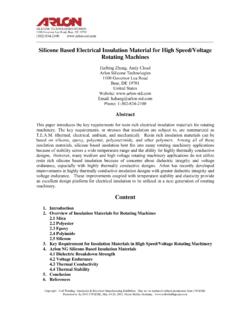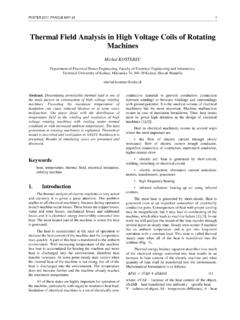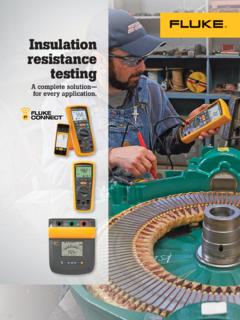Transcription of PERMISSIBLE LOADING OF GENERATORS AND …
1 FACILITIES INSTRUCTIONS, STANDARDS, AND TECHNIQUES Volume 1-4 PERMISSIBLE LOADING OF GENERATORS AND LARGE MOTORS Internet Version of This Manual Created July 2000 The appearance of the Internet Version of This Manual May Differ From the Original, but the Contents Do Not FACILITIES ENGINEERING BRANCH DENVER OFFICE DENVER, COLORADO UNITED STATES DEPARTMENT OF THE INTERIOR BUREAU OF RECLAMATION REVISED MARCH 1991 Purpose and Scope This volume is intended to fill the need for practical information concerning the temperature and mechanical and electrical overload limits of rotating electric equipment such as GENERATORS and large motors. rotating electrical equipment cannot be overloaded on the same basis as transformers and is not as able to stand short-time overloads. This is largely because equipment cooled by air does not have the heat transfer ability which the higher thermal conductivity of insulating oil gives to transformers; also, the windings in rotating equipment are confined in slots in the steel and are subject to temperature expansion problems.
2 For any abnormal LOADING of GENERATORS , the electrical , mechanical, and thermal characteristics must be evaluated to determine the machines limitations. Machines should not be loaded beyond the manufacturer's defined overload capability unless a complete study of the unit has been made to define safe limits. Additional tests might have to be conducted to substantiate the possibilities for higher-than-rated loadings. CONTENTS Paragraph Page 1. Types of insulation used on rotating machines, their insulation life, and deterioration causes ..1 Thermoplastic (asphalt-mica) ..1 Thermosetting (polyester-mica or epoxy-mica) ..12. Mechanical limitations ..13. Damage caused by expansion of copper ..24. Limiting temperatures for insulation ..25. Hottest spot allowance.
3 36. Limiting temperature rise ..37. Operation of machines under warranty ..38. Operation up to rated capacity ..39. Short-time and emergency Load limitations of associated equipment ..811. Cooling water ..812. Cooling water Supplemental cooling ..914. Keeping machines clean ..9 15. Temperature of old machines ..916. Changing voltage to reduce Load temperature tests ..1018. Measuring stator temperature ..1019. Measuring field temperature ..1020. Computing stator winding temperature rise ..1121. Generator capability curves ..11 0verexcited (boosting voltage) ..13 Underexcited (bucking voltage) ..13 22. References ..161. TYPES OF insulation USED ON rotating MACHINES, THEIR Thermoplastic (asphalt-mica).-The useful life of a thermoplastic (asphalt-mica) insulation system is practically ended when the insulation has become brittle enough to develop cracks under the mechanical stresses to which it is subjected.
4 A direct cause of embrittlement is operation at high temperatures; cracking results from mechanical stresses imposed upon conductors having brittle insulation . The mechanical stresses are caused by (a) short-circuit currents, (b) thermal expansion andcontraction of the conductors, and (c) vibration. The dielectric strength of insulation is not significantly reduced by brittleness alone; however, electrical breakdown may quickly follow the development of ensuing cracks, especially when moisture and contaminants invade the system through the cracks. Another cause of failure in asphalt-mica windings is the migration of the asphalt compound when the coil operating temperature reaches the flow point of the asphalt. As the compound migrates, the space formerly occupied by the compound becomes a void, subject to localized interior corona deterioration and resultant failure.
5 This type of deterioration is more predominant in the phase terminal end of the winding where the voltages to ground are high enough to produce corona discharges. Evidence of asphalt compound migration would be bulges in coil tape, usually at the lowest point in the coil. It has been known for coils to remain in service, without failure, for years even if all the asphalt compound had migrated. This is not a healthy condition, but the only remedies are reduced load or rewinding the generator. Thermosetting (polyester-mica or epoxy-mica).-The useful life of thermosetting (polyester mica or epoxy-mica) insulation systems has not yet been determined as they have not been in service long enough to determine the eventual effects of aging.
6 To date, the main cause of failure of thermosetting insulation systems has been vibration due to looseness in slots. Thermosetting insulation systems have proven to be especially prone to developing loose wedges and slot discharge because the "hard" nature of the insulation system does not mold itself to fit the slot as the old asphalt-mica system did. New installation methods, such as the use of spring type wedge fillers, are being used to control the tendency of thermosetting systems to become loose in the slots. It appears that proper installation techniques may solve this problem. 2. MECHANICAL LIMITATIONSL arge and high-voltage hydrogenerators built in accordance with ANSI 1965 may be operated up to 115 percent load at rated power factor, frequency, and voltage, with the stator and rotor temperatures in excess of normal for these machines.
7 Although this load level does not define the actual temperature rises, it does define the mechanical limit as the value on the machine at rated power factor and 115 percent kVA. For example, a generator with a rated power factor of would actually be operating at 128 percent of the mechanical rating if it was loaded to 115 percent kVA and unity power factor. If it is intended to operate units with rated power factors less than unity at 115 percent kVA and unity power factor, the Denver Office should obtain the manufacturer's concurrence that the machine has this mechanical capability. For other unusual conditions such as short-time overloads, unbalanced load operation, harmonic current loadings, etc.
8 , industry standards do not make any specific provisions. Additionally if persistent vibrations at some fixed frequency during operation should occur due to hydraulic forces, the resonant frequencies of rotating parts and associated components should be investigated because usually no allowance has been made for this condition in the original design. Each such case should again be discussed with the manufacturer to establish safe limits. 1 (FIST 1-4 3/91) 3. DAMAGE CAUSED BY EXPANSION OF COPPER Temperature rise places stricter limits on loads than consideration of total temperature alone, Copper windings have a greater coefficient of expansion than stator steel, and in addition, are usually at a higher temperature.
9 Under widely fluctuating temperatures, portions of the coils move in the steel slots with which they are in contact and abrasion and cracking of insulation may result. This movement is greater for machines with long slots than short slots, and increases with temperature rise. Since temperature rise varies approximately as the square of the load, it can be seen that a machine which must be overloaded should have its load maintained as constant as possible. This may be accomplished by holding constant load on the overloaded machine as much as possible, and carrying the fluctuating portion of the system load on other machines which are not overIoaded. The rate of load increase on cold machines should be limited to not more than 10 percent of rated load per minute except in emergencies when it is essential to pick up load promptly.
10 This restriction does not apply to decreasing load, nor to varying load on a warmed-up generator. Hydroelectric GENERATORS used for peaking power generation are sometimes loaded at the gate opening speed when peaking power is required on short notice. An example of the damage (tape separation) done to asphalt-mica insulated coils by excessive coil expansion and contraction is shown in figure 1. 4. LIMITING TEMPERATURES FORINSULATION The safe operating temperature of rotating machine windings is limited by the heat which insulating material will stand without abnormal deterioration. This varies with different classes of insulating materials as shown in table 1. The hottest spot temperatures shown in the table have very little, if any, margin of safety for continuous operation.



















